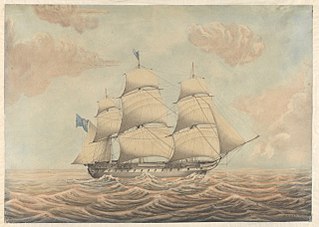
HMS Arethusa was a 46-gun Leda-class fifth-rate frigate built for the Royal Navy during the 1810s. The ship was never commissioned and was converted into a lazarette in 1836. She was renamed HMS Bacchus in 1844 and was further converted into a coal hulk in 1851–52. The ship was sold for scrap in 1883.

HMS Melampus was a 46-gun modified Leda-class fifth-rate frigate built for the Royal Navy during the 1810s. Completed in 1820, she was not commissioned until 1845 for the South America Station and was converted into a store and receiving ship in 1855. The ship was briefly assigned as a coast guard ship before being paid off in 1858. Melampus was converted into a Roman Catholic chapel ship in 1866 and then became a store ship twenty years later. The ship was sold for scrap in 1906.
HMS Nereus was a 46-gun modified Leda-class fifth-rate frigate built for the Royal Navy during the 1810s. She was never commissioned and was converted into a store ship in 1843 for service in South America. The ship was sold for into civilian service in 1879.
HMS Thisbe was a 46-gun modified Leda-class fifth-rate frigate built for the Royal Navy during the 1820s. The ship was never commissioned and spent her entire career in reserve or on third-line duties. She was converted into a depot ship in 1850 and then into a floating church in 1863. Thisbe was replaced by a shore-based establishment, All Souls Chapel, in 1891 and sold for scrap the following year.
HMS Druid was a 46-gun Seringapatam-class fifth-rate frigate built for the Royal Navy during the 1820s, the name ship of her sub-class.

HMS Nemesis was a 46-gun Seringapatam-class fifth-rate frigate built for the Royal Navy during the 1820s, one of four ships of the Druid sub-class.

HMS Leda was a 46-gun Seringapatam-class fifth-rate frigate built for the Royal Navy during the 1820s, one of seven ships of the Druid sub-class.

HMS Stag was a 44-gun Seringapatam-class fifth-rate frigate built for the Royal Navy during the 1820s, one of three ships of the Andromeda sub-class.
HMS Seahorse was a 44-gun Seringapatam-class fifth-rate frigate built for the Royal Navy during the 1820s, one of three ships of the Andromeda sub-class. After completion in 1830, she was ordered to be converted into a steam-powered ship in 1845, but this did not happen for another decade.
HMS Racer was a 6-gun Nightingale-class cutter built for the Royal Navy in 1818. She was broken up in 1830.
HMS Speedy was a 6-gun Nightingale-class cutter built for the Royal Navy during the 1820s. She was broken up in 1876.
HMS Snipe was a 6-gun Nightingale-class cutter built for the Royal Navy during the 1820s. She was broken up in 1860.

HMS Meteor was a Hecla-class bomb vessel built for the Royal Navy during the 1820s. In July 1832 she was renamed Beacon and reclassified as a survey ship, and was sold in 1846.

HMS Talbot was a 28-gun Atholl-class sixth-rate frigate built for the Royal Navy during the 1820s.

HMS Satellite was an 18-gun sloop, the name ship of her class, built for the Royal Navy during the 1820s.
HMS Comus was an 18-gun sloop, the name ship of her class, built for the Royal Navy during the 1820s.
HMS Larne was an 18-gun Comet-class sloop built for the Royal Navy during the 1820s. She was broken up in 1866.

HMS Lily was a 16-gun Racer-class brig-sloop built for the Royal Navy during the 1830s.

HMS Harlequin was a 16-gun Racer-class brig-sloop built for the Royal Navy during the 1830s.
HMS Persian was a sixteen-gun Acorn-class brig-sloop built for the Royal Navy during the 1830s.









